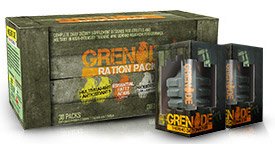
8 Ways To Speed Up Muscle Growth
Looking to make the most of your time under the iron? Build slabs of quality mass faster with these 8 tips from WBFF pro Jamie Alderton!
Building muscle can be a slow and frustrating process for even the most committed lifters, especially if you've spent an appreciable amount of time under the bar. You might have grown like a weed when you first started training, but over time, consistent muscle growth requires new strategies and tactics. If your journey to more muscle has stalled, a few tweaks to your program might be all you need!
Thankfully, WBFF pro Jamie Alderton is here to share some of his favorite tips and techniques to kick your muscle-building efforts into high gear. Wherever you are on the road to packing on more quality mass, try a few of these tips to supercharge your results!
Go Slow to Grow
When it comes to packing on size, you might actually want to slow down your lifts to elicit new growth. "Too many people focus on trying to lift heavy and fast to speed up muscle growth," Alderton says. "This often leads to sloppy form and takes the focus off of the working muscles."
"While adding weight to your lifts helps you grow, it comes secondary to stimulating the muscle through a full range of motion," he adds. If you let a heavy load get in the way of proper form and tempo, you aren't doing yourself any favors.
Form and controlled speed are crucial. "A key mechanism for building muscle is mechanical tension, which is created when a muscle is stretched and contracted repeatedly with a challenging weight," Alderton explains. Consider watching yourself perform each rep of an exercise to check your form, and then focus on lifting and lowering the weight slowly and under control.
"What most people don't realize is that the eccentric phase of the lift is just as effective at building muscle as the concentric phase," Alderton adds. The eccentric—or lowering—portion of the lift creates more muscle damage, which is another essential mechanism of muscle growth.
"Slowing down your reps in the eccentric phase of your lifts will not only cause you to lift through a greater range of motion, it will also increase the time that the muscle is under tension," Alderton adds. This, in short, can lead to greater muscle gains.
Grab a Spot
When lifting near your one-rep max or pushing past failure on your muscle-building sets, training with a spotter is extremely beneficial. Even if you don't use your partner's assistance on every rep, knowing he or she has your back will help you push harder than you otherwise would. Over time, this extra effort translates to greater strength progression and muscular adaptation.
A spotter can also help you perform specific training techniques like assisted and eccentric (negative) reps to push past sticking points and stimulate new growth. During assisted reps, you lift to failure, and then have your spotter assist you with a few additional reps beyond that point.
During negatives training, you load up with a weight heavier than you'd normally rep out and focus entirely on a slow eccentric, or lowering, component of the rep. Your partner helps you with the positive portion.
Maintain a Caloric Surplus
Muscle won't grow without adequate cause. To build it effectively, you need an adequate training stimulus followed by ample nutrition and recovery. Getting enough daily calories is a critical component of adding quality size. "If you really want to speed up your muscle growth, you need to fuel your body effectively," Alderton adds.
The best way to do this is to take in more calories than you burn. A 250-calorie surplus—or 250 calories over what you're currently eating, or your maintenance goal—is a great starting point, but be sure to monitor progress over time and adjust accordingly. While you don't want to embark on a caloric free-for-all and start packing on body fat, you also don't want to have too small of a surplus. If your surplus is null, you'll be building muscle at a snail's pace. If you're in that boat, start eating 500 calories over your daily maintenance level.
Not sure where you stand? A trick Alderton uses to guesstimate how many calories he needs to build muscle is to take his body weight in pounds and multiply by 18-20. If he's not growing after eating in that range for a few weeks, he'll slowly increase his calories. If you're wondering how to find your maintenance calorie level, just multiply your body weight by 15 for an easy place to start.
Know Your Maxes
Another key to getting stronger—and therefore building more muscle—is knowing your limits. "What is your 3-rep, 5-rep, and 8-rep max for the compound lifts?" Alderton asks. "If you don't know the answer to that, it could be part of your problem."
Why? Because knowing these numbers will allow you to program smart workouts. Instead of blindly guessing how many reps you can complete on a certain lift with a certain weight, you'll be able to select the appropriate load—and progressively increase it—from workout to workout. This kind of systematic tracking will help you get bigger and stronger for the long haul.
If you don't already, Alderton recommends that you test your main-lift maxes every 2-3 months to monitor progress and ensure you're lifting heavy enough during your day-to-day workouts. You might be stronger than you realize, but if you fail to test, you'll never match your potential.
Use a Workout Log
When it comes to making solid gains, tracking your training sessions is essential. "Make sure that you log your sets and reps, as well as the amount of weight you are lifting in each session," Alderton insists.
Having a log to look at each time you hit the gym will not only inspire you to do your best, but it will allow you to double-check that you are, in fact, doing more than you did last workout. It's hard to know where to go if you don't know where you've been, so write down your sets and reps so you can beat them in your next session!
If you don't log your lifts or cardio sessions, it's much harder to tell if you're moving forward. And if you keep using the same weight day after day, you're simply maintaining the status quo. A good workout log can help prevent this.
Fuel for Every Workout
Simply put, if you want to have a great workout, you have to fuel for peak performance. Training on empty can leave you feeling weak and underpowered during your workouts, and failing to fuel after a session can hamper your recovery and long-term growth.
So, what's the perfect pre-workout meal? Well, that depends on your meal frequency and other factors, but a mix of complex carbohydrates and roughly 30 grams of lean protein 1-2 hours before you lift is ideal. Getting in another 20-30 grams of protein after you lift can spur muscle protein synthesis and help you build muscle over time, so don't overlook either crucial period.
Limit Your Cardio Activity
Incorporating moderate-intensity cardio is great for improving your aerobic capacity and enhancing your ability to work hard for a prolonged period during weight training. However, when muscle size and strength are your top goals, more cardio isn't always the best solution. If you do too much cardio, it can make it harder to achieve the size and strength gains you desire.
Cardio places additional stress on the body, which means you have more to recover from, and it can sap calories that could have gone toward your muscle-building efforts.
To experience optimal muscle growth while training your heart, keep your cardio to 2-3 times per week and limited to 20-30 minutes per session at a low-moderate intensity.
Don't Get Married to One Equipment Type
When it comes to lifting, remember that your body will respond best to a variety of stimuli. Avoid getting too focused on lifting with just one type of equipment at all times. You might favor barbells and dumbbells, but that doesn't mean you should never lift using cables or weight machines.
Change up your routine every so often to place the muscles under a new type of stress.



